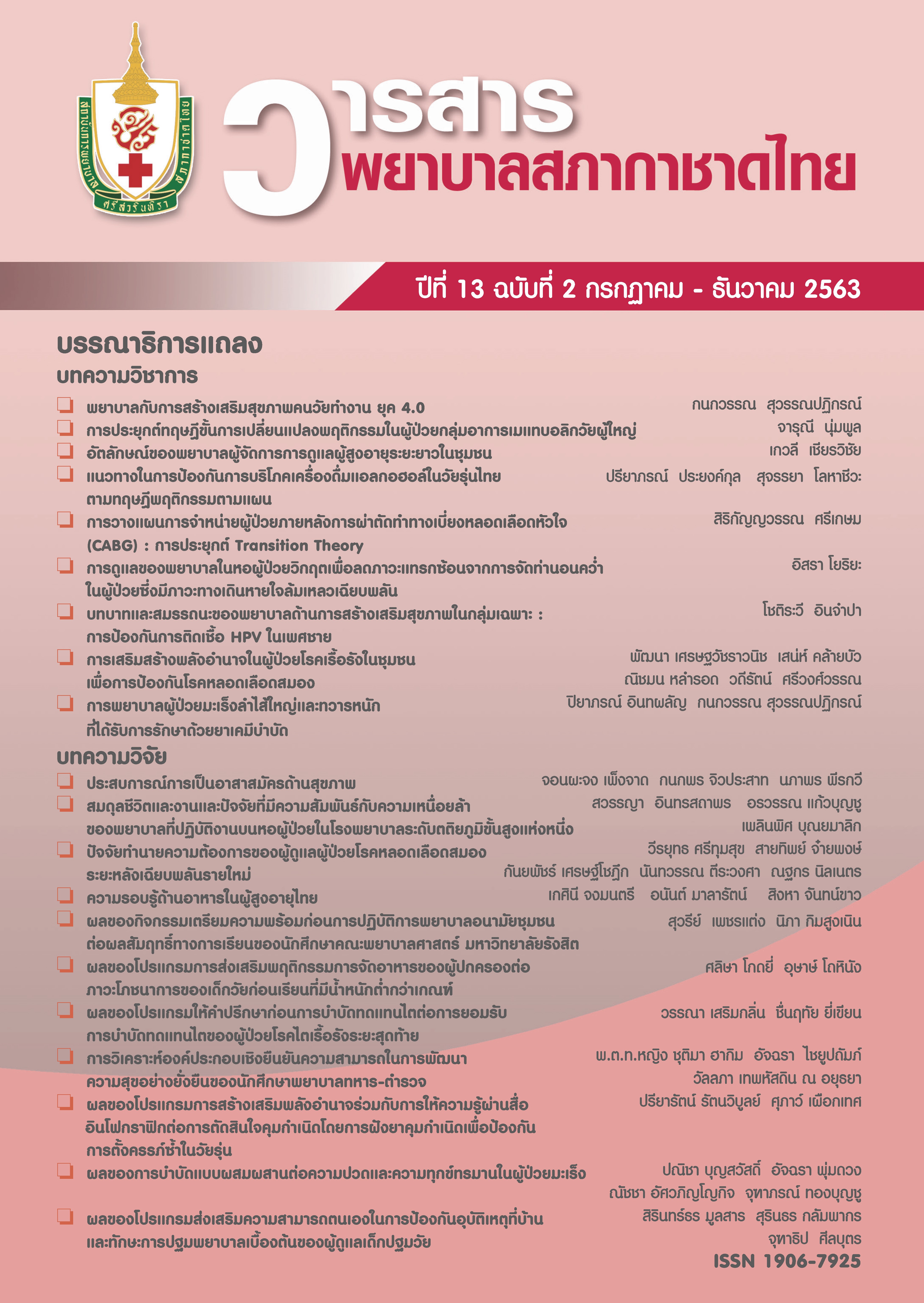Effect of Empowerment Program and Infographics on Contraceptive Implant Used for Repeated Adolescent Pregnancy Prevention
Keywords:
empowerment program, contraceptive implant, infographics media, repeated adolescent pregnancy preventionAbstract
This was a quasi–experimental research aimed to study the effect of an empowerment program and accompanying infographics for implanted contraceptive for repeated adolescent pregnancy prevention. The sample was 80 adolescent postpartum young women at Queen Savang Vadhana Memorial Hospital divided into two groups, half in the control group and half in the experimental. The control group received normal nursing, while the experimental group received the empowerment program according to the stages of Gibson’s concept, including: (1) discovering reality, (2) critical reflection, (3) taking charge, and (4) holding on. The material for the experimental group was the empowerment program and motion graphic titled, “Prevention of Repeated Adolescent Pregnancy”. The tools for data collection were a record sheet for the contraceptive method that the sample used to prevent repeated pregnancy. Chi–square test was used to analyze the data.
The results revealed that adolescent postpartum women in the experimental group decided to use contraceptive implants for the prevention of repeated pregnancy at a significantly higher rate than the control group (x2 = 6.054, P< .05), It is therefore recommended that healthcare teams should apply this empowerment program to adolescent postpartum women who decide to use contraceptive implants for reducing the chance of repeated adolescent pregnancy.
References
2. Omar HA, Fowler A, McClanahan KK. Significant reduction of repeat teen pregnancy in a comprehensive young parent program. J Pediatr Adolesc Gynecol 2008;21(5):283-7.
3. Srivilai K. Repeated pregnancy among adolescents: a case study in a community Hospital, Southern Thailand. The Southern College Network Journal of Nursing and Public Health 2016; 3(3):142-52. (in Thai)
4. Rowlands S. Social predictor of repeat adolescent pregnancy and focused strategies. Best Pract Res Clin Obstet Gynaecol 2010;24(5):605-16.
5. Srivilai K. Effect of empowerment program on behaviors for prevention of repeated Pregnancy among postpartum teenage women [Thesis]. Songkla: Songkla University; 2011. (in Thai)
6. Lewis LN. Doherty DA. Hickey M. Implanon as a contraceptive choice for teenage mothers: a comparison of contraceptive choices, acceptability and repeat pregnancy. Contraception 2010;81(5):421-6
7. Bureau of Reproductive Health. Department of Health. Ministry of Public Health. Teenage pregnancy: policy, operating guidelines and evaluate. Nonthaburi: Agricultural Cooperative Printing Demonstrations of Thai; 2014. (in Thai)
8. Chunin R, Saejeng K, Sukrat B. Contraceptive service provision of hospitals in Thailand in 2015. Rama Med J 2016;39(2):117-31. (in Thai)
9. Bureau of Reproductive Health. Department of Health. Ministry of Public Health. ACT for prevention and solution of the adolescent pregnancy problem, B.E. 2559 [Internet]. 2016 [cited 2018 Jun 8]. Available from http://202.44.139.133/publicRelation/anc_doc/ 20170808135629.pdf (in Thai)
10. Vanichvasin P. Potentials of using infographics in enhancing the quality of learning. Panyapiwat Journal 2015;7(Special Issue): 227-40. (in Thai)
11. Gibson CH. The Process of empowerment in mother of chronically ill children. J Adv Nurs 1995;21(6):1201-10.
12. Cochran WG. Sampling techniques. 5th ed. New York: John Wiley & Sons; 1977.
13. Bureau of Reproductive Health Department of Health. Thailand reproductive health database 2017 [Internet]. 2019 [cited 2020 Jun 20]. Available from: http://rhdata.anamai. moph.go.th/index.php/familyplanning/familyplanning17 (in Thai)
14. Bureau of Reproductive Health. Department of Health. Department of Health Annual Report 2018 [Internet]. 2019 [cited 2020 Jun 20]. Available from: http://planning.anamai. moph.go.th/download/D_report_year/2561.pdf (in Thai)
15. Boonnow S. Knowledge, attitudes and satisfaction about contraception to prevent pregnancy repeat of teenage mother at postpartum department, Chaiyaphum hospital. Chaiyaphum Medical Journal 2016;36(2):35-43. (in Thai)
16. Wattanathamrong V, Sirisopon N, Kainaka P, Onsiri S, Amipie C, Anek A, et al. Factors related intention contraception type implants in repeat pregnancies adolescents. Journal of The Royal Thai Army Nurses 2017;18(Suppl. Jan-Apr):102-11. (in Thai)
17. Jumklang S. Srisuriyawet R. Homsin P. Correlated factors with decision making of birth control implant used based on the information-motivation behavioral skills model (IMB model) among teen mothers. The Journal of Faculty of Nursing Burapha University 2017; 25(2):31- 42. (in Thai)
18. Yantarapakorn A, Mahuwan P, Kamtep P, Raksanor R, Tharatthai R, Navasri A. Development of a motion graphic media titled: effect from mobile phone usage for 9th grade students at Ratniyom school, Sai Noi District, Nonthaburi. Proceedings of The 2nd International and 4th National Academic Conference: Research and Innovation in Health; 29 -30 Nov 2018; Bangkok: Academic Institute of public health and medical technology network; 2018. (in Thai)
19. Chuchot R. The birth control campaign in adolescents: the roles of smart nurse 4.0. Journal of The Royal Thai Army Nurses 2018; 19(Supple. May-Aug):42-52. (in Thai)
Downloads
Published
Issue
Section
License
เนื้อหาบทความหรือข้อคิดเห็นต่างๆ ในวารสารพยาบาลสภากาชาดไทยนี้ เป็นความคิดเห็นของผู้เขียนบทความ ไม่ใช่ความเห็นของกองบรรณาธิการ หรือสถาบันการพยาบาลศรีสวรินทิรา สภากาชาดไทย






